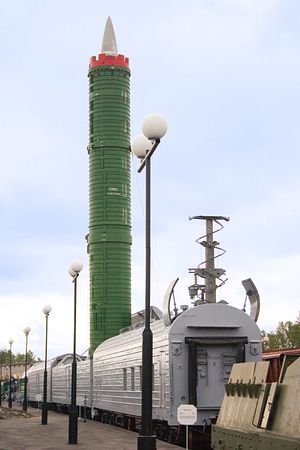A report submitted by the Russian Defense Ministry to the Kremlin confirms that Russia will move ahead with an updated rail-mounted missile system for Inter-Continental Ballistic Missiles. Russia hasn’t had a rail-mounted ICBM system since it dismantled the last of its Soviet-era SS-24s in 2008. RIA Novosti reported that Russia will “deploy rail-mounted nuclear missiles as a potential response to the United States’ Prompt Global Strike program.” The U.S. prompt global strike program is an ongoing effort to develop a capability to deliver a precise conventional weapon strike anywhere on Earth within one hour.
Rail-mounted ICBMs address the weaknesses of conventional silo-based ICBMs – the most obvious improvement being increased maneuverability. Given Russia’s immense strategic depth due to its size, a mobile ICBM delivered via rail would effectively guarantee the survivability of its ICBMs after a hypothetical first strike. This was the logic that drove the Soviet-era development of the SS-24.
The SS-24 program consisted of 14 silo-based ICBMs and 42 rail-based platforms with a range of 6,200 miles and a capability to deliver up to 10 warheads to separate targets via a multiple independently targetable reentry vehicle capability (MIRV).
Russian strategic thought on nuclear deterrence harkens back to the days of the Cold War with its single-minded focus on balancing against the perceived threat from the United States’ missile positions. Commander of the Russian Strategic Missile Troops (RSVN), Col. Gen. Sergei Karakayev told Interfax Russia’s strategic deterrent depended on 1,500 nuclear warheads – deliverable via a variety of methods.
“It is necessary to have about 1,500 nuclear warheads in the shock troops of the Russian strategic nuclear forces in order to resolve tasks of strategic deterrence. The United States have approximately the same number,” Karakayev said, revealing the continued impact of U.S. positioning on Russian strategy.
Despite continued efforts by the U.S. and Russia to reduce absolute numbers of nuclear warheads through agreements on limiting strategic weapons, Russia is concerned by technological advances such as the conventional prompt global strike technology.
A report published earlier this year by the Carnegie Endowment suggests that the United States’ conventional prompt global strike technology could precipitate a miscalculated nuclear exchange by allowing observing states to wrongly conclude the trajectory of a launch and take nuclear retaliatory action preemptively. The hypersonic missiles used by the United States could raise anxieties in Russia which has an advanced early-warning intelligence capability, allowing it to detect any U.S. launches with ample time to respond in kind.
Target ambiguity is another issue presented by the prompt global strike weapons. James Acton, the author of the Carnegie Endowment report, writes that “A state could mistakenly believe that its nuclear forces were under attack when its conventional forces were really the target.” The prompt global strike system is non-nuclear, intended to strike targets several thousands of miles away with little warning.
The idea of revisiting rail-based ICBMs was raised earlier this year, with concerns about whether existing railway infrastructure could support potential future launches. The force exerted by an ICBM as it is launched requires a special sort of reinforced railroad track that has not been maintained since the heyday of Soviet Union.
Current advances in Russian missile technology might allow for a significantly lighter missile to be used, bypassing the infrastructure problem. Another concern is secrecy – rail-based launchers can be easily located today. According to a Russian defense ministry insider cited by the Global Security Newswire, “Missile trains ought to be moving secretly, the way they did in the USSR, but we do not live in the Soviet Union anymore. This is Russia, and Russia is different.”

































